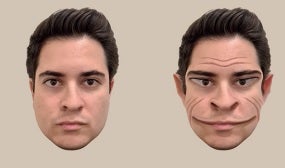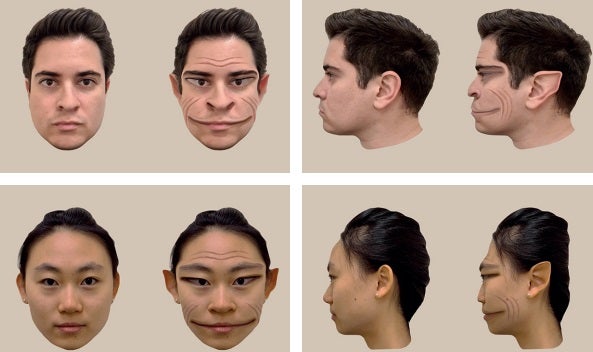Distorted ‘demon face’ images show how people with rare neurological disorder see others
Prosopometamorphopsia (PMO) is an extremely rare visual disorder that alters the sufferer’s perception of faces

Computer-generated images give an idea of what a person living with “demon face” syndrome might see when they look at someone.
Prosopometamorphopsia (PMO) is an extremely rare visual disorder that alters the sufferer’s perception of faces.
A 58-year-old man with a 31-month history of seeing people’s faces distorted and, in his words, appearing “demonic” visited a university laboratory for an assessment.
After assessments, the researchers concluded that he had PMO.
The patient, who had a history of bipolar and post-traumatic stress disorder, said the distortions presented as severely stretched features of the face, with deep grooves on the forehead, cheeks, and chin.
But he reported no distortions when looking at objects such as houses or cars.
Although the faces were distorted he was still able to recognise who they were, he told researchers at the Department of Psychological and Brain Sciences, Dartmouth College, Hanover, New Hampshire, USA.

“Notably,” the researchers said, “he reported no distortions when viewing facial images on a screen or on paper.”
The distortions were not accompanied by delusional beliefs about the identities of the people he encountered—such as his family or friends.
The patient had a significant head injury at the age of 43 years that led to hospitalisation.
He also had possible carbon monoxide poisoning at the age of 55 years, which occurred four months before the onset of his distortion symptoms.
He was not prescribed any medications and said he did not use any illicit substances.
Using feedback from the patient and photo editing software, the researchers then created rough images of what he saw when he looked at human faces.
“We hope this has a big impact in the way people think about PMO, especially for them to be able to understand how severe PMO can be,” Antonio Vitor Reis Goncalves Mello, one of the study’s authors, said.
The study was published The Lancet journal on 23 March.
Join our commenting forum
Join thought-provoking conversations, follow other Independent readers and see their replies
Comments
Bookmark popover
Removed from bookmarks